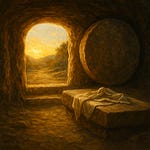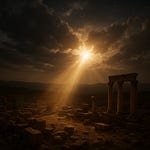When someone is learning about Jesus (or coming back to faith), there’s one GIANT question that blocks the doorway to all other discussion. That rock is what I want to discuss today.
“Can we trust the Gospel accounts?”
It doesn’t make sense to discuss the miracles or the resurrection or the path to salvation if we can’t first agree that the text we’re working from is reliable.
Question One: What genre of writing are the gospels?
Answer:
Matthew, Mark, Luke, and John are either written by eyewitnesses or by people directly connected to eyewitnesses. We call them Greco-Roman biographies to be technical (bioi is the greek term).
This type of writing has several features (that the gospels match):
Focused on the life and character of a central figure.
Written not just to inform, but to model behavior.
Didn’t require exhaustive detail (like modern biographies). Selectivity was expected.
Often highlighted death as the climactic event.
There are many biographies that historians widely accept as reliable such as Suetonius’s The Twelve Caesars, Plutarch’s Lives, and Tacitus’s Agricola. All of these written about a character in roughly same time period, even though the earliest manuscripts found are 800 years or more after the events.
Question Two: How many manuscripts have we found?
Answer:
There are over 5,800+ Greek manuscripts of the Gospels, and 20,000+ manuscripts written in other languages. By comparison, Homer’s Iliad has around ~1,800, Caesar’s Gallic Wars around ~10, and Tacitus’s Annals ~3.
Case in point, the Gospels blow every single other ancient text out of the water in terms of the amount of manuscripts we have available.
Question Three: When were the Gospels written?
Answer:
Most scholars date the Gospels between 60–100 AD. Mark is the earliest. And even though Paul’s writing aren’t the focus of this argument, some of the letters to the Churches date even earlier.
The reason this is so important is because the time between when the events happened and when they were written down, is TINY. There would have been eyewitnesses around who could easily refute the writing if it was fabricated.
The earliest manuscripts we have found are dated ~125 AD (about 30 years after John was written). They were found in Egypt (showing how fast the Gospel spread).
Later manuscripts show remarkable stability in the text. In fact, even the most skeptical historians admit that the “disparities” in the texts are minimal and are more about grammar than theology.
Question Four: How can we trust that Matthew, Mark, Luke, and John were telling the truth?
Answer:
There are three features of the Gospels that lend to their credibility, and they are:
Embarrassing Details
External Corroboration
Undesigned Coincidences
Let’s go through each one (paying special attention to #3).
#1 Embarrassing Details
Peter denies Jesus. Disciples misunderstand constantly. Women are the first witnesses (culturally embarrassing in 1st century). These details weaken the case if fabricated, but strengthen it if true.
#2 External Corroboration
Josephus: references Jesus, James, and crucifixion. Tacitus confirms execution under Pontius Pilate. Pliny the Younger: records early Christian worship of Christ “as a god.”
#3 Undesigned Coincidences
They’re little details in one Gospel that don’t make full sense until you read another Gospel. These overlaps are too subtle to be intentional, but too coherent to be coincidence. They look like the natural byproduct of multiple eyewitnesses remembering the same event from different angles.
For example, in the feeding of the 5000 (both in John 6 and Mark 6):
John 6:5: Jesus tests Philip by asking, “Where shall we buy bread for these people to eat?” Why Philip? Seems random…
Mark 6:30–44 explains: the miracle happened near Bethsaida. Philip was from Bethsaida (John 1:44).
The pieces click. John drops Philip’s name, Mark gives the location, Luke confirms Philip’s hometown. Together, it makes perfect sense.
If the Gospels were fabricated centuries later, you’d expect polished consistency, not hidden puzzle pieces. Forgers don’t leave subtle clues across documents that only scholars or close readers would notice. This is exactly what you see in real eyewitness testimony: rough edges that overlap in ways that can’t be staged.
Now we get to the heart of the matter when it comes to the Gospels.
They recount miracles. This is why people call them into question. If there had been no miracles written about, the Gospels would be accepted by virtually everyone.
^^ Most people breeze over this fact but it is remarkable. Take out the miracles and no one would be arguing “Are the Gospels reliable?”
If you have a worldview that cannot or does not accept miracles, you’ll look for a way to make the Gospel accounts irrelevant and false.
Miracles are the stumbling block.
Ask 10 people on the street if they believe in miracles, and you’ll probably get the following responses:
“Yes I believe in them.”
“Maybe they are possible but extraordinary claims need extraordinary evidence.”
“If they are true, why don’t we see them today?”
“No I do not believe that anything claiming to happen outside the laws of nature is real.”
I’m curious how you would answer the question?
As we move into the next episode, we’ll look at a Biblical worldview that accepts miracles vs. a worldview that does not. But when you look at the evidence presented about the reliability of the Gospel manuscripts, we can’t simply write them off as myths and legends.
You must decide for yourself:
Either the Gospels are historically reliable accounts of a man who claimed to be God and performed miracles… or they are early, widespread, meticulously preserved accounts that somehow all got it completely wrong.
And if you feel the tension of such black-and-white options, you’ll find that most other worldviews don’t like that tension either, and do the “hunt & peck” method of the Gospels.
They’ll accept some pieces, but not all.
Islam for example claims that Gospels were distorted. They throw away the death & resurrection, and His claim that He was God. This doesn’t match the evidence presented as we have tons of examples of the preservation of the text. And non-religious historians acknowledge that Jesus did in fact die on a cross.
You’ll find similar logical inconsistencies among buddhists, new agers, etc. They’ll accept Jesus’ wisdom or even His miracles, but strip away His exclusivity. It’s picking and choosing, not dealing with the whole picture.
Among world religions, Orthodox Judaism at least takes the evidence seriously. They don’t deny the miracles or dismiss the reliability of the text. Instead, they argue Jesus was a false prophet whose power came from the wrong source. Whether you agree or not, that’s at least a logically consistent position.
They aren’t ignoring the mountain of evidence for the manuscripts and their reliability, they are simply attributing it to something that wasn’t God.
So we’re back at the fork in the road.
The Gospels are either reliable eyewitness accounts of a man who claimed to be God and performed miracles…or they’re early, widespread, carefully preserved accounts that all somehow got it completely wrong.
The evidence forces us back to Jesus Himself, and especially His resurrection. That’s where we need to go next.







